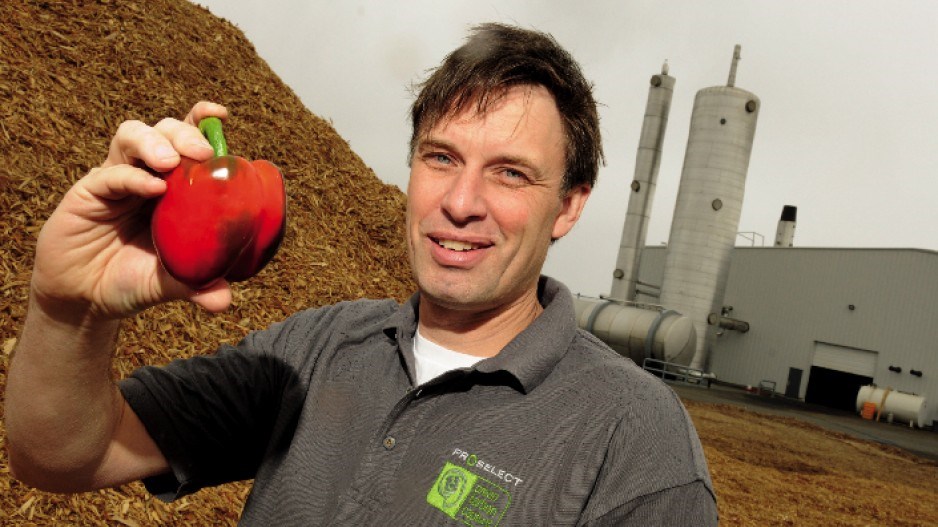One of the paradoxes of greenhouses is the greenhouse gases produced in their operation.
Plants absorb carbon dioxide, which is why CO2 needs to be injected into greenhouses.
But CO2 – a greenhouse gas that contributes to global warming – is also produced when fossil fuels are burned to heat greenhouses in the winter.
Many greenhouse operators also burn natural gas to produce the CO2 needed to grow their produce.
That never made sense to Victor Krahn, whose family's business, SunSelect Produce Inc., has greenhouses in Aldergrove and Delta.
Is there no way, he wondered, to pull the CO2 from the gases created from burning wood waste and then use it in greenhouses?
He found an answer in Holland, where engineers with the company Procede BV had developed a process that can do just that.
In 2009, SunSelect and Procede formed the ProSelect Gas Treating Inc. joint venture. With $1 million in funding from Sustainable Development Technology Canada (SDTC) and $2.24 million from the Innovative Clean Energy (ICE) fund, they built what Krahn claims is the first carbon capture and recycling system for greenhouses: the ProSelect GC6. Although there are obvious environmental benefits to the technology, Krahn’s motivation for developing it was more about saving the money than saving the planet.
"We're really just farmers," Krahn said. "We developed this technology because we have a need to reduce our costs."
To lower fuel costs, SunSelect switched to burning wood waste a few years ago to heat the greenhouses. The cost of natural gas might be dropping, but wood chips are still far cheaper. However, they don't burn very cleanly.
"We could only use it for heat in the winter," Krahn said. "In the summer, when we have our biggest CO2 demands, because the plants are growing so well, we still had to use natural gas or liquid CO2."
With the GC6 system, the smoke from a wood burner used to heat the greenhouses is run through filters to remove particulates. The gas then goes through an absorber column, where chemical solvents pull the CO2 from the gas. What's left of the emissions is mainly water vapour.
The CO2-rich water-based solvents can be stored in a buffer tank until the CO2 is needed. The solvents are heated, the CO2 is boiled off and then pumped into the greenhouse.
Krahn said the gas from the desorber is 99% to 100% pure CO2. The absorbents can be reused.
The system has been tested for a year now, and Krahn said it saves his company about $1 million a year on natural gas and CO2. And because it reduces carbon emissions, it's eligible for carbon credits. Krahn said the credits offset about 20% of ProSelect's fuel costs.
The pilot plant at SunSelect's 40-acre greenhouse operation in Delta cost $5 million to build, but Krahn said plants can be built for $3 million or less.
"It's a five-year payback," Krahn said.
ProSelect's plan is to build the systems for other greenhouse operators as turnkey operations. Krahn said the potential markets for the technology include Canada, Europe and the U.S.
In addition to the money the GC6 system saves, it reduces the greenhouse's carbon footprint.
Matt Horne, director of climate change for the Pembina Institute, calculates the B.C. greenhouse industry's carbon footprint to be about 200,000 tonnes of CO2.
ProSelect isn't the only local company working on innovative carbon capture technology.
Burnaby's Inventys Thermal Technologies Inc. is developing a carbon capture system to improve the recovery of oil. Unlike the ProSelect system, however, the Inventys system uses adsorption, not absorption. Its patented VeloxoTherm process uses a honeycomb-shaped matrix of adsorbents that attract CO2 molecules from gases and then releases it again using steam heat. Once recovered, the CO2 is compressed into a liquid and then pumped into the ground either for sequestration or increased oil recovery.
In November, Suncor Energy(TSX:SU) signed a research and development agreement with Inventys to build a VeloxoTherm pilot plant in Burnaby. •




